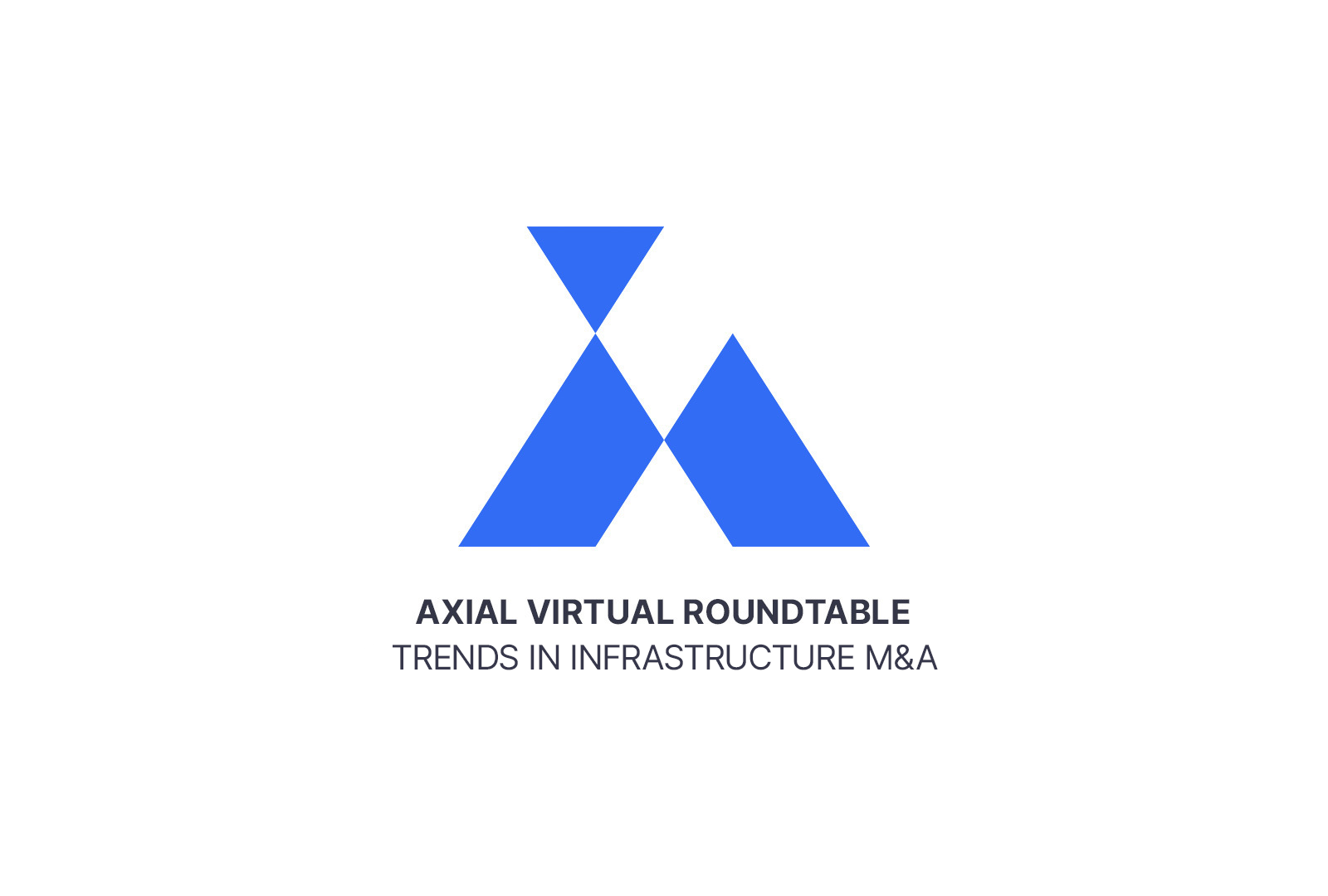Infrastructure has dominated headlines in recent weeks as congress continues to negotiate the Biden administration’s proposed infrastructure spending bill. The $1.2T bipartisan bill aims to repair critical infrastructure throughout the country, while providing a much needed boost to a still-recovering job market. As the bill gets finalized, infrastructure businesses anxiously stand by, preparing to compete with one another for the project work that will eventually materialize as a result of the passing of the bill.
Earlier this week, we sat down with four Axial members and LMM-focused M&A professionals to discuss trends in the infrastructure space. The relationship between the public and private sector and how those dynamics impact the attractiveness of an infrastructure business as an investible asset was a major topic of conversation. We also discussed what types of businesses are being included in the increasingly broad definition of infrastructure, the focus on cybersecurity capabilities at infrastructure businesses, and the growth of sustainability focused infrastructure investment opportunities.
Thank you to the following Axial members who participated in the discussion:
Video
Audio
Show Notes
Introductions | 00:00 – 5:45
Defining Infrastructure | 5:46
- Historically, infrastructure was synonymous with asset-heavy businesses and projects such as highways, roads, and ports. There is an increasing number of asset-light infrastructure businesses in the services space that have been generating more attention from the M&A community.
- Joe Dunfee: Important to consider the LP and what they’re hoping to get out of their allocation to infrastructure, which is typically an investment that’s uncorrelated to broader market swings that produces a stable return, with some element of recurring yield. There are a few ways that can be achieved. Investing in concessionary or real estate-based businesses that’s either guaranteed by the government or the real assets that they own, or by providing an essential service to a region, tends to protect the asset from the broader market and economic cycles.
- The migration from industrial-based businesses to digital-based businesses has also changed the definition of infrastructure to focus less on capex and more on the return profile and ability to operate despite broader market conditions. It comes down to whether an investor can say that they’ve met the LP’s objective of achieving uncorrelated, stable returns.
- Mark Wienberg: Another key consideration in assessing infrastructure businesses is whether there’s a possibility of creating a platform investment, allowing you to target smaller add-on deals. There’s also considerations related to control / non-control investments and how that impacts multiple arbitrage on the exit side.
- From an independent sponsor perspective, the focus tends to be on businesses that aren’t as capex intensive. It’s easier to pitch a deal to financial sponsors that don’t have the same level of capex as heavy industrial businesses, as an example. The cement and traffic control businesses are examples of deals that Stone Road has done that they consider to be infrastructure.
- Rob Lubin: There are many ancillary businesses that touch classic infrastructure that could also be considered infrastructure. A business that builds tunnels is classic infrastructure. Is the hauling business that takes the stone to the landfill considered infrastructure? Is the landfill considered infrastructure? Lots of funds have recently branded themselves as infrastructure funds. It’s always interesting to hear what that means for them.
Government Spending Programs – A Wind in the Sails of the Infrastructure Industry | 13:18
- Rick Briggs: The American Cares Act that was signed into law in May was an instant shot in the arm for a lot of infrastructure businesses, including one that Consilium has in market at the moment.
- Mark Wienberg: Government spending is in part what’s driven the broad definition of infrastructure, because of the breadth of what’s included in the spending plan.
- There’s also been a correlated uptick in the amount of “infrastructure” deals that are being marketed at the moment. There’s a lot of deal flow and a lot of money to be spent in the space. It requires buyers to conduct even more meticulous due-diligence because there’s a lot of supply out there that frankly shouldn’t be.
- Rick Briggs: There’s been a shift from a sellers market to a buyers market recently. Lots of business owners are trying to get deals done before taxes potentially go up at the end of the year. That’s also contributed to the volume of deals in the infrastructure space recently.
The Infrastructure Bill | 18:11
- In the United States, a 1% increase in private infrastructure investment contributes 2x as much to the economy as the same investment in public infrastructure
- Joe Dunfee: There’s a big difference between what’s invested in on the public and private side of infrastructure. Municipalities and state governments can issue tax exempt bonds to finance projects, which has limited private investment in a lot of heavy infrastructure verticals. There’s almost no opportunity for private investors to invest in toll roads, bridges, and projects of that nature. It has bifurcated the market where effectively mostly transportation and other super heavy infrastructure projects are the purview of the public sector, while the private sector goes after the smaller projects in the fiber, wireless, and things of that nature that are more accessible from a check size and permitting perspective.
- There’s a large opportunity to increase the productivity of public spending by increasing access to urban centers. Spending on transportation to urban areas can enable individuals who did not have access to high-paying jobs, which can contribute significantly to the economy over the long term. Rebuilding the same old infrastructure does not provide the same level of economic stimulation as net new projects that increase job growth and overall GDP. That’s not to say infrastructure repairs aren’t necessary, but public spending has the ability to contribute more to the economy if it’s done right.
Public Private Partnerships | 23:48
- Mark Wienberg: While states and municipalities may get all this money to spend, it’s not the state employees who will actually be doing the project work. The money gets farmed out to construction entities and all of the sub-categories that contribute to those projects.
- Environmental and engineering reviews of public infrastructure frequently receive low scores, which is quite scary to consider. There’s a lot of work to be done which creates opportunity for prime construction companies and the sub-contractors they hire to complete projects. The ultimate payer is the state or the municipality.
- Maintenance businesses are enticing from an investment standpoint for that reason. As opposed to winning a one-time contract to build a road, maintenance is ongoing.
- It’s important for businesses to have a good mix of both government and non-government clients. The concentration of that customer base also tends to vary based on the specific vertical that the business operates in. Traffic control for example will be more of a blend. Heating, oil, and propane tend to be mostly private. Road building is almost exclusively government.
- Rick Briggs: Currently representing a road paving business. Lots of questions and passes from investors because of the technicalities and customer concentration that comes with those types of businesses.
- Strategics on the other hand are much more interested in road building businesses because of how steady they tend to be. The work is predictable. Bifurcation between how financial and strategic buyers view these businesses.
- Rob Lubin: Government entities tend to be double edged swords. The work is predictable, but payment cycles tend to be extremely long making it difficult to forge relationships with banks, as an example.
Construction Business | 36:22
- Construction businesses represented the largest discrepancy in supply and demand on the Axial network in the industrials category. Construction businesses made up almost 40% of all industrial deals brought to market via Axial in the last 18 months, while only 5% of industrial focused buyers included construction in their investment mandates.
- Mark Wienberg: Capex of your typical construction business is a tough pill for buyers to swallow. It’s also difficult to build out construction platform investments.
- Geography also plays a major factor in the demand (or lack thereof) of construction businesses. Regulation varies state-by-state which makes it more or less attractive to pursue deals based on those state specific laws.
Infrastructure Cybersecurity | 39:40
- Joe Dunfee: Securing your assets from cyber attacks is becoming increasingly important for portfolio managers. Investors who spend the time protecting assets will be able to demand a premium at exit because of the security of the asset.
- Essential services, which is a large part of the infrastructure industry, have become more frequently targeted by cyber criminals, increasing the attention that investors both assessing new opportunities and operating existing portfolio companies are placing on cybersecurity.
- Investment firms are increasingly building out cyber capabilities at the fund level to get ahead of any potential threats at the portfolio company level.
- Rob Lubin: Cyber capabilities are becoming a more and more important part of the investment banking due diligence process. It’s almost as important at this point as legal and accounting diligence. Ensuring that the seller is prepared to answer tough questions about their cyber capabilities is key.
- Rick Briggs: Financial buyer due diligence teams have increasingly included a systems expert who can audit the companies hardware and software infrastructure. Cybersecurity is coming up more and more. Lots of questions about cyber insurance.
The Digital Divide | 45:42
- Joe Dunfee: Telecommunications is becoming an increasing focus for private equity. What was a pure venture play 20 years ago has become a private equity play because of the growth profile of telecom businesses.
- The needs to support telecom businesses is almost infinite, given the increase in mobile usage and accessibility to the internet.
- Lots of cutting edge technology coming out to close out the last mile of the digital divide, providing internet to everyone in the country regardless of their location.
- The government helped in trying to bridge the digital divide through the cares act. When learning went remote last year, a lot of families did not have basic internet access to allow their children to participate in “Zoom school.”
- Increasing broadband in rural areas had to come at the expense of the government because the economics don’t really make sense from an investment perspective.
Popular Infrastructure Investment Segments | 50:30
- Mark Wienberg: There’s robust activity in construction, water maintenance, sewers and pipelines at the moment.
- Digital infrastructure is incredibly interesting. Critical piece of infrastructure that’s only going to become more important.
- Joe Dunfee: Digital has been picking up but that’s been happening for a few years already. Sustainability and environmental is experiencing tremendous growth. Hottest sector right now.
- Rob Lubin: Lots of deals coming to market in the sustainability area. A lot of businesses in the US are trying to replicate European sustainability business models, but are having a hard time doing so.
- Rick Briggs: Most important factor in any deal at the moment is having a well defined growth story. If you can’t show it and make it stick, the deal will not happen, especially in this environment. There’s so much supply out there at the moment. Buyers are inundated with opportunities. Getting through to them with how you’re different and presenting a compelling growth story is key.

